Latest recommendations

| Id | Title | Authors | Abstract | Picture | Thematic fields | Recommender▲ | Reviewers | Submission date | |
|---|---|---|---|---|---|---|---|---|---|
23 Aug 2023
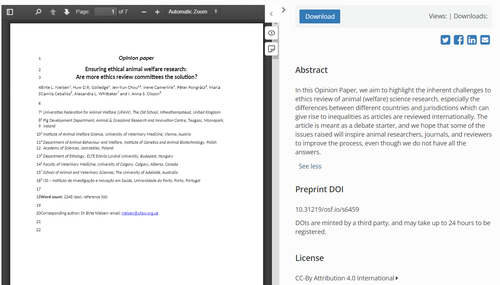
Ensuring ethical animal welfare research: Are more ethics review committees the solution?Birte L. Nielsen, Huw D.R. Golledge, Jen-Yun Chou, Irene Camerlink, Péter Pongrácz, Maria Camila Ceballos, Alexandra L. Whittaker and I. Anna S. Olsson https://www.doi.org/10.31219/osf.io/s6459Can a consensus be reached on the ethical review of animal experimentation for livestock species?Recommended by Hervé Acloque based on reviews by Christian Nawroth, Patrick Gonin and Leon borgdorf"Ensuring ethical animal welfare research: Are more ethics review committees the solution?" by Birte Nielsen and colleagues [1] provides food for thought on the ethical assessment of experiments involving farm animals. While regulations can provide a precise framework, they differ from country to country and do not consider several cases, mainly when the experimentation involves non- or minimally invasive manipulations. It is also the case when research projects use farmed animals that do not fall within the scope of the regulations on animal experimentation but have undergone practices that can be authorised on farms but may raise ethical questions (tail docking, live castration, tooth filing, beak trimming, dehorning). On the other hand, the heterogeneity of the criteria taken into account by the ethics committees, when they exist (and this can differ greatly from one country to another), do not necessarily correspond to the criteria of the journals, the reviewers and the bodies brought in to evaluate the research project, or to the regulations specific to each country. All these paradoxes lead the authors to propose solutions, the most straightforward and spontaneous of which is to ask ourselves questions about this issue upstream of the experimental design required to answer a given scientific question. While increasing the number of ethical review committees may be an insufficient option, the authors insist on the importance of improving committee members' training, taking into consideration jurisdictions' differences between countries and spending more time on ethics evaluation during manuscripts' reviewing. In addition, the upstream assessment of research projects by ethics committees, specific to an institution (research institute, universities, companies), a scientific publisher or even a dedicated international ethical review board may also be a good option. The ethical evaluation of research projects is a question at the heart of our research activities, for which we do not have all the answers. As with scientific reviewing, we must take on the role of evaluator or be evaluated ourselves, using criteria and feelings that are not always consensual. The heterogeneity of evaluation systems within the scientific community, the lack of training for scientists in the fundamentals of ethical evaluation, and the different perceptions of the animal condition between countries and cultures can lead to a reciprocal lack of understanding between evaluator and evaluated, and sometimes a feeling of injustice, as some research may be easy to conduct in one country but difficult in another. Indeed, it is exciting to read the exchanges between the authors and the three reviewers who assessed this opinion paper to appreciate the diversity of points of view and see specific points of divergence. In addition to animal experimentation, the judgment handed down on 30 June 2023 by the French court penalising a pig farmer for the abusive use of an authorised breeding practice (tail docking) is a perfect illustration of the fact that the ethical assessment of practices and handling of farm animals now extends far beyond the scientific world and is becoming an increasingly important factor in the relationship between society and animal breeding. Failure to consider this evolution, whether in experimentation or animal husbandry, may have legal consequences and increase the lack of understanding between our practices and how society perceives them. The questions raised and the solutions proposed in the article by Nielsen et al. are central to our concerns, not only for the scientific community but also to meet the expectations of all stakeholders. Finally, although the authors do not directly address the question of genome editing and research using edited farm animals, this is and will be at the heart of future issues concerning the ethical evaluation of research projects. As with practices and manipulations, the intentionality of the modifications induced leads us to question and evaluate, in farmed species, their consequences on animal welfare and their relevance to society and the development of more sustainable and socially accepted animal husbandry. Reference [1] Nielsen, B. L., Golledge, H. D. R., Chou, J., Camerlink, I., Pongrácz, P., Ceballos, M., Whittaker, A. L., Olsson, I. S. (2023) Ensuring ethical animal welfare research: Are more ethics review committees the solution? OSF Preprints. Ver. 3 peer-reviewed and recommended by Peer Community in Animal Science. https://doi.org/10.31219/osf.io/s6459 | Ensuring ethical animal welfare research: Are more ethics review committees the solution? | Birte L. Nielsen, Huw D.R. Golledge, Jen-Yun Chou, Irene Camerlink, Péter Pongrácz, Maria Camila Ceballos, Alexandra L. Whittaker and I. Anna S. Olsson | <p>As the article is a short Opinion Paper, it has no abstract, but it aims to highlight the inherent challenges to ethics review of animal (welfare) science research, especially the differences between different countries and jurisdictions which ... |  | Animal behaviour , Animal welfare, Open science, Veterinary science | Hervé Acloque | 2023-05-05 13:27:22 | View | |
24 Mar 2023
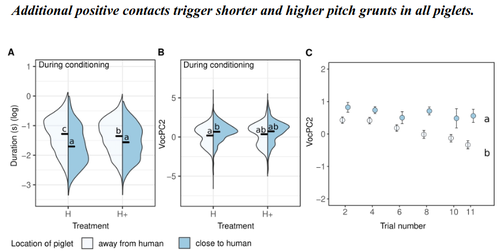
The use of pigs vocalisation structure to assess the quality of human-pig relationshipAvelyne S Villain, Carole Guérin, Céline Tallet https://doi.org/10.1101/2022.03.15.484457Qualitative aspects of grunts vary with pigs' mental statesRecommended by Isabelle Veissier based on reviews by Matteo Chincarini and 1 anonymous reviewerVillain et al., (2023) investigated the structure of vocalisations in piglets in relation to human-animal-relationship. They first established a positive relationship by habituating piglets to be positively handled at weaning or later on after weaning. They then compared the reactions of piglets previously positively handled at weaning to that of non-handled piglets during tests in presence of a human (interacting or not), and also before and after the conditioning period when all piglets received positive contacts. They showed that the duration and frequency of grunts emitted in the presence of the human depends on previous contacts. More specifically, grunts are shorter and higher pitched in pigs that have been positively handled, in line with a positive human-animal relationship which is also observed through proximity of the piglets with the human. The authors concluded that the structure of pig vocalisation can reflect the quality of their relationship with humans. The authors also showed that not only the response to humans is modified by positive contacts but also the general mood of piglets, with piglets positively handled at weaning emitting shorter grunts than non-handled piglets, whatever the context. Another interesting finding is the temporality of behaviour of pigs habituated to positive contacts: during the first tests, they stay close to the human, probably being reassured by the proximity of the human. Then, when tests are repeated, they explore more the test room, using the human as an exploratory basis as already reported in the literature. The hypotheses of the study are clear. The methods are reported in details so that the work is reproducible. The interpretation of results is sound. The manuscript is clearly written. This paper brings new and original knowledge in the field of animals’ emotional responses and human-animal relationship: on the structure of grunts in relation to positive affects (positive emotion, positive mood) and on the temporality of the responses to human presence. I recommend this manuscript for its originality and quality. Isabelle Veissier Villain, A.S., Guérin, C., Tallet, C., 2023. The use of pigs vocalisation structure to assess the quality of human-pig relationship. bioRxiv 2022.03.15.484457, ver. 5 peer-reviewed and recommended by Peer Community in Animal Science. https://doi.org/10.1101/2022.03.15.484457 | The use of pigs vocalisation structure to assess the quality of human-pig relationship | Avelyne S Villain, Carole Guérin, Céline Tallet | <p>Studying human-animal interactions in domestic species and how they affect the establishment of a positive Human-Animal Relationship (HAR) may help us improve animal welfare and better understand the evolution of interspecific interactions asso... |  | Animal behaviour , Animal cognition, Animal welfare | Isabelle Veissier | 2022-03-23 09:34:45 | View | |
14 Oct 2020
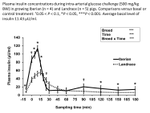
Determining insulin sensitivity from glucose tolerance tests in Iberian and Landrace pigsJ. M. Rodríguez-López, M. Lachica, L. González-Valero, I. Fernández-Fígares https://doi.org/10.1101/2019.12.20.884056Iberian pigs: more than excellent ham!Recommended by Jordi Estellé based on reviews by 2 anonymous reviewersIberian pigs represent a treasured resource that allows the maintenance of their “montanera” traditional breeding system and, thus, contributes to the socioeconomic sustainability of the rural areas in the south-western regions of Iberian Peninsula. While the excellence of Iberian meat products is widely recognized, the idea of using Iberian pigs as biomedical models is currently emerging. Interestingly, due to the particular fatty acid metabolism of this porcine breed, Iberian pigs have been proposed as models for type 2 diabetes (Torres-Rovira et al. 2012) or obesity-related renal disease (Rodríguez et a. 2020). In the present manuscript, Rodríguez-López et al. provide further insights on the particularities of “obese” Iberian pigs by comparing their insulin sensitivity in a glucose tolerance test with that of commercial “lean” Landrace pigs. The authors compared four Iberian pigs with five Landrace pigs in an intense time-series following an intra-arterial glucose tolerance test and measuring insulin, glucose, lactate, triglycerides, cholesterol, creatinine, albumin and urea plasma levels. Several of these parameters showed significant differences between both breeds, with some of them being compatible with an early stage of insulin resistance in Iberian pigs. These results are relevant from an animal production perspective, but provide also further evidence for considering the Iberian pigs as a suitable biomedical model for obesity-related disorders. References [1] Torres-Rovira, L., Astiz, S., Caro, A., Lopez-Bote, C., Ovilo, C., Pallares, P., Perez-Solana, M. L., Sanchez-Sanchez, R., & Gonzalez-Bulnes, A. (2012). Diet-induced swine model with obesity/leptin resistance for the study of metabolic syndrome and type 2 diabetes. The Scientific World Journal, 510149. https://doi.org/10.1100/2012/510149 | Determining insulin sensitivity from glucose tolerance tests in Iberian and Landrace pigs | J. M. Rodríguez-López, M. Lachica, L. González-Valero, I. Fernández-Fígares | <p>As insulin sensitivity may help to explain divergences in growth and body composition between native and modern breeds, metabolic responses to glucose infusion were measured using an intra-arterial glucose tolerance test (IAGTT). Iberian (n = 4... |  | Monogastrics, Physiology, Pig nutrition | Jordi Estellé | 2019-12-28 10:51:03 | View | |
06 Sep 2019
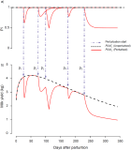
Lactation curve model with explicit representation of perturbations as a phenotyping tool for dairy livestock precision farming.Ben Abdelkrim Ahmed, Puillet Laurence, Gomes Pierre, Martin Olivier https://doi.org/10.1101/661249Developing smart fitting algorithms to identify random perturbations in time-series dataRecommended by Luis Tedeschi based on reviews by Alberto Atzori, Jennifer Spencer and 1 anonymous reviewerThe ability to adequately characterize the lactation curve of livestock is important not only to ensure proper nutrition of the lactating animal but, among many other benefits, it can assist in diagnosing the incidence of diseases, predicting the quantity of milk production, and comparing animals within the herd for managerial strategies such as culling. Eventually, such smart fitting algorithms can lead to improved genetic selection of more productive animals after genetic-unrelated noises are removed from the data, systematically. References [1] Johansson, I. (1961). Genetic Aspects of Dairy Cattle Breeding. University of Illinois Press, Urbana, IL. [2] Nelder, J. A. (1966). Inverse polynomials, a useful group of multi-factor response functions. Biometrics. 22 (1):128-141. doi: 10.2307/2528220 | Lactation curve model with explicit representation of perturbations as a phenotyping tool for dairy livestock precision farming. | Ben Abdelkrim Ahmed, Puillet Laurence, Gomes Pierre, Martin Olivier | <p>Background Understanding the effects of environment on livestock provides valuable information on how farm animals express their production potential, and on their welfare. Ruminants are often confronted with perturbations that affect their per... |  | Lactation biology , Mathematical modelling, Precision livestock farming | Luis Tedeschi | 2019-06-07 09:38:26 | View | |
05 Dec 2019
Effects of feeding treatment on growth rate and performance of primiparous Holstein dairy heifersYannick Le Cozler, Julien Jurquet, Nicolas Bedere https://doi.org/10.1101/760082Optimizing growth rate of dairy heifers through nutrition to maximize reproduction and productionRecommended by Luis Tedeschi based on reviews by Emilio Mauricio Ungerfeld and 2 anonymous reviewersThe idea of altering the growth rate of replacement heifers to improve reproductive and productive indicators of dairy cattle is not new. In the late 1970s, Gill and Allaire [1] indicated that the first parturition between 22.5 to 23.5 months of age yielded the optimum lifetime performance as long as the heifers had adequate body size [2]. Since 1980s, many studies have been conducted to understand the partitioning of energy between growth and lactation, including the impact of growth rates on the heifer puberty [3] as well as growth and development of the mammary gland [4,5]. The senior author of the recommended study has written previously about this research topic [6]. In the present manuscript, Le Cozler et al. studied the effect of feeding programs to increase the growth rate of late-born heifers to catch up with the growth of those born earlier in the calving season on their reproductive and productive performance. The authors analyzed 217 heifers for three consecutive years, split into three dietary treatments: control (C), accelerated growth rate from birth to 6 months of age (ID1), or accelerated growth rate from birth to 12 months of age (ID2). In this study, the late-born heifers receiving the ID2 treatment were able to partially reach the bodyweight of the early-born heifers at 24 months of age. In part, the incomplete understanding of the prioritization of the use of energy (and other nutrients) for different physiological stages (e.g., maintenance, growth, lactation, and pregnancy) of the dairy animal [7] undercuts the development of more robust feeding strategies to improve the reproductive and productive performance of the animal. In the recommended study by Le Cozler et al., although there was no impact on reproductive performance among groups, heifers in the group ID2 produced less milk (about 400 kg for the whole first lactation) than heifers in the groups C and ID1, apparently suggesting that energy allocation for growth had priority over that needed for lactation. The question then becomes what would have happened with energy partitioning if energy intake was restricted. Studies like this one are important to shed some light on the prioritization of the use of energy and other nutrients in support of growth, pregnancy, and lactation of dairy animals, and how compensatory growth differs between meat versus dairy growing animals, both physiologically and energetically. References [1] Gill, G. S., & Allaire, F. R. (1976). Relationship of Age at First Calving, Days Open, Days Dry, and Herdlife to a Profit function for Dairy Cattle1. Journal of Dairy Science, 59(6), 1131–1139. doi: 10.3168/jds.S0022-0302(76)84333-0 | Effects of feeding treatment on growth rate and performance of primiparous Holstein dairy heifers | Yannick Le Cozler, Julien Jurquet, Nicolas Bedere | <p>The objective of this study was to investigate effects of feeding-rearing programs that aim for first calving at 20-27 months (mo) of age on growth, reproduction and production performance of Holstein cows at nulliparous and primiparous stages.... | Cattle production, Reproduction, Ruminant nutrition | Luis Tedeschi | 2019-09-09 09:22:36 | View | ||
16 Apr 2021

Modelling the impact of the macroalgae Asparagopsis taxiformis on rumen microbial fermentation and methane productionRafael Muñoz-Tamayo , Juana C. Chagas, Mohammad Ramin, Sophie J. Krizsan https://doi.org/10.1101/2020.11.09.374330Understanding the mechanisms behind natural bioactive compounds that can potentially reduce methane production in anaerobic conditions. A case study of Asparagopsis taxiformisRecommended by Luis Tedeschi based on reviews by Alberto Atzori, Henk van Lingen and 2 anonymous reviewersNaturally occurring compounds that can reduce methane production in anaerobic conditions have been studied for quite some time as feasible approaches to mitigate methane production in ruminant animals, especially those of commercial importance. Asparagopsis taxiformis (red algae) and Dictyota bartayresii (brown algae) are effective inhibitors of methane synthesis under in vitro anaerobic fermentation systems (Machado et al., 2014) likely because of their high concentration of secondary metabolites that are toxic to the typical rumen microbiota, including protozoa. In addition to phytoplankton (Palmer and Reason, 2009), Asparagopsis contains a high concentration of haloform compounds (e.g., bromoform, chloroform) while Dictyota has a high concentration of isoprenoid terpenes. Despite the economic and biological impact of diverse phytochemicals on reducing methane production in ruminant animals (Tedeschi et al., 2021), haloform compounds’ environmental impact and safety, in particular, are still unclear. In the present study, Munõz-Tamayo and collaborators (2021) listed relevant literature about the impact of A. taxiformis on ruminal methane production. Concurrent to the understanding of mechanisms and biology behind the reduction of ruminal methane, mathematical models can lead the way to enhance the effectiveness of feeding A. taxiformis under commercial applications. Thus, in the present study, Munõz-Tamayo and collaborators (2021) sought to develop a mathematical model to understand the rumen fermentation changes in vitro experimentation containing extract of A. taxiformis by adapting a previously documented model by Muñoz-Tamayo et al. (2016). Modeling development, calibration, and evaluation steps should be independent of each other, requiring complete, distinct, and separate databases (Tedeschi, 2006). However, in rare circumstances where such requirements cannot be met because data availability is scarce, the cross-validation technique, when possible, should be considered to assess data dispersion’s effects on model adequacy. In other situations, clear reasoning for failing to do so must be addressed in the paper. In the present paper, Munõz-Tamayo and collaborators (2021) explained the limitations in their modeling efforts were primarily due to the lack of ideal data: “experiments with simultaneous dynamic data of bromoform, volatile fatty acids, hydrogen, and methane.” Regardless of the availability of ideal data, improvements in the conceptual model are warranted to include amino acids and branched-chain fatty acids fermentation dynamics in the rumen and the fluctuations in ruminal pH. References Machado L, Magnusson M, Paul NA, Nys R de, Tomkins N (2014) Effects of Marine and Freshwater Macroalgae on In Vitro Total Gas and Methane Production. PLOS ONE, 9, e85289. https://doi.org/10.1371/journal.pone.0085289 Muñoz-Tamayo R, Chagas JC, Ramin M, Krizsan SJ (2021) Modelling the impact of the macroalgae Asparagopsis taxiformis on rumen microbial fermentation and methane production. bioRxiv, 2020.11.09.374330, ver. 4 peer-reviewed and recommended by PCI Animal Science. https://doi.org/10.1101/2020.11.09.374330 Muñoz-Tamayo R, Giger-Reverdin S, Sauvant D (2016) Mechanistic modelling of in vitro fermentation and methane production by rumen microbiota. Animal Feed Science and Technology, 220, 1–21. https://doi.org/10.1016/j.anifeedsci.2016.07.005 Palmer CJ, Reason CJ (2009) Relationships of surface bromoform concentrations with mixed layer depth and salinity in the tropical oceans. Global Biogeochemical Cycles, 23. https://doi.org/10.1029/2008GB003338 Tedeschi LO (2006) Assessment of the adequacy of mathematical models. Agricultural Systems, 89, 225–247. https://doi.org/10.1016/j.agsy.2005.11.004 Tedeschi LO, Muir JP, Naumann HD, Norris AB, Ramírez-Restrepo CA, Mertens-Talcott SU (2021) Nutritional Aspects of Ecologically Relevant Phytochemicals in Ruminant Production. Frontiers in Veterinary Science, 8. https://doi.org/10.3389/fvets.2021.628445 | Modelling the impact of the macroalgae Asparagopsis taxiformis on rumen microbial fermentation and methane production | Rafael Muñoz-Tamayo , Juana C. Chagas, Mohammad Ramin, Sophie J. Krizsan | <p>Background: The red macroalgae Asparagopsis taxiformis is a potent natural supplement for reducing methane production from cattle. A. taxiformis contains several anti-methanogenic compounds including bromoform that inhibits directly methanogene... |  | Agricultural sustainability, Animal nutrition modelling, Emissions , Mathematical modelling, Microbial fermentation, Rumen microbiology, Rumen microbiome | Luis Tedeschi | 2020-11-17 06:28:29 | View | |
31 Jul 2023

The big challenge for livestock genomics is to make sequence data payMartin Johnsson https://doi.org/10.48550/arXiv.2302.01140The price of sequencing the livestock genomicsRecommended by Marcin Pszczoła based on reviews by Mario Calus and 1 anonymous reviewerUsing sequence data in livestock genomics has often been regarded as a solution to revolutionize livestock breeding (Meuwissen & Goddard, 2010). The main expected benefits were to enhance the accuracy of breeding values, achieve better persistence of the accuracy over generations, and enable across populations or breed predictions (Hickey, 2013). Despite the promised benefits, whole-genome sequencing has not yet been implemented in livestock breeding programs, replacing SNP arrays for routine evaluation. In this work, Johnsson (2023) thoroughly reviewed the literature regarding the implications of whole-genome sequencing and functional genomics for livestock breeding practice. The author discusses the potential applications and reasons for difficulties in their implementation. The author speculates that the main challenge for making using the sequence data profitable is to overcome the problem of the small dimensionality of the genetic data and proposes three potential ways to achieve this goal. The first approach is better modeling of genomic segments, the second inclusion of undetected genetic variation, and the third use of functional genomic information. The paper presents an original and interesting perspective on the current status of the use of sequence data in livestock breeding programs and perspectives for the future. References Hickey,J.M.,2013.Sequencing millions of animals for genomic selection 2.0. Journal of Animal Breeding and Genetics 130:331–332. https://doi.org/10.1111/jbg.12054 Johnsson, M., 2023. The big challenge for livestock genomics is to make sequence data pay. arXiv, 2302.01140, ver. 4 peer-reviewed and recommended by Peer Community in Animal Science. https://doi.org/10.48550/arXiv.2302.01140 Meuwissen, T., Goddard, M.,2010. Accurate prediction of genetic values for complex traits by whole-genome resequencing. Genetics 185:623–631. https://doi.org/10.1534/genetics.110.116590
| The big challenge for livestock genomics is to make sequence data pay | Martin Johnsson | <p>This paper will argue that one of the biggest challenges for livestock genomics is to make whole-genome sequencing and functional genomics applicable to breeding practice. It discusses potential explanations for why it is so difficult to consis... |  | Genomics, Genomic selection | Marcin Pszczoła | 2023-02-03 08:08:39 | View | |
24 May 2022
Identifying cattle with superior growth feed efficiency through their natural 15N abundance and plasma urea concentration: a meta-analysis.Gonzalo Cantalapiedra-Hijar, Isabelle Morel, Bernard Sepchat, Céline Chantelauze, Gemma A. Miller, Carol-Anne Duthie, Isabelle Ortigues-Marty, Richard J. Dewhurst https://doi.org/10.5281/zenodo.578396015N as a marker for feed efficiency in beef cattleRecommended by Marcos Marcondes based on reviews by Emilio Mauricio Ungerfeld and 1 anonymous reviewerIdentifying individuals with a more remarkable feed efficiency may positively affect the profitability and sustainability of the beef industry (Cruz et al., 2010; Basarab et al., 2013). However, although most international nutrient requirements systems predict animal feed efficiency, intake data is usually unavailable at the farm level, and ranking animals based on efficiency might be challenging. In this sense, using differences in the occurrence of isotopic N between animal and diet (Δ15Nanimal-diet) might become a natural biomarker to determine feed efficiency at the farm level. This methodology was firstly demonstrated by Guarnido-Lopez et al. (2021). In the present study by Cantalapiedra-Hijar et al. (2022), the authors evaluated the extent to which Δ15Nanimal-diet can be used as a marker for feed efficiency in beef animals. For this, a meta-analysis was conducted using a database including 759 individual records for performance and N isotopic discrimination measured in plasma or muscle (Δ15Nanimal-diet; n = 749) and plasma urea concentration (n = 659). The database was composed of 37% Charolais, 15% Simmental, and 40% of beef crossbreds. The results confirmed that Δ15Nanimal-diet could discriminate animals with at least 0.10 kg/kg difference in feed efficiency. Furthermore, the Δ15Nanimal-diet marker also successfully discriminated the feed efficiency of two animals from the same contemporary group if they differ by at least 0.06 kg/kg of FCE. However, when trying to predict feed efficiency, using the two candidate biomarkers did not improve estimates. Lastly, when data from biomarkers were combined with performance data, improvement in the predictions was observed. Nonetheless, the present results warrant more studies to evaluate the use of Δ15Nanimal-diet as a biomarker for feed efficiency since it could be used not only for feed efficiency discrimination but also in genetic selections.
References Cantalapiedra-Hijar G, Morel I, Sepchat B, Chantelauze C, Miller GA, Duthie CA, Ortigues-Marty I, Dewhurst RJ (2022). Identifying cattle with superior growth feed efficiency through their natural 15N abundance and plasma urea concentration: A meta-analysis. Zenodo, 5783960, ver. 3 peer-reviewed and recommended by Peer community in Animal Science. https://doi.org/10.5281/zenodo.5783960. Cruz GD, Rodríguez-Sánchez JA, Oltjen JW, Sainz RD (2010). Performance, residual feed intake, digestibility, carcass traits, and profitability of Angus-Hereford steers housed in individual or group pens. J. Anim. Sci. 88:324-329. https://doi.org/10.2527/jas.2009-1932. Basarab JA, Beauchemin KA, Baron VS, Ominski KH, Guan LL, Miller SP, Crowley JJ (2013). Reducing GHG emissions through genetic improvement for feed efficiency: effects on economically important traits and enteric methane production. Animal 7:303-315. https://doi.org/10.1017/S1751731113000888. Guarnido-Lopez P, Ortigues-Marty I, Taussat S, Fossaert C, Renand G, Cantalapiedra-Hijar G (2021). Plasma proteins Δ15N vs. plasma urea as candidate biomarkers of between-animal variations of feed efficiency in beef cattle: Phenotypic and genetic evaluation. Animal 15:100318. https://doi.org/10.1016/j.animal.2021.100318.
| Identifying cattle with superior growth feed efficiency through their natural 15N abundance and plasma urea concentration: a meta-analysis. | Gonzalo Cantalapiedra-Hijar, Isabelle Morel, Bernard Sepchat, Céline Chantelauze, Gemma A. Miller, Carol-Anne Duthie, Isabelle Ortigues-Marty, Richard J. Dewhurst | <p>The objective of this study was to test two candidate biomarkers of feed efficiency in growing cattle. A database was built using performance data from 13 trials conducted with growing heifers, steers and young bulls and testing 34 dietary trea... | Physiology, Ruminant nutrition | Marcos Marcondes | 2021-12-07 15:24:15 | View | ||
09 Feb 2024
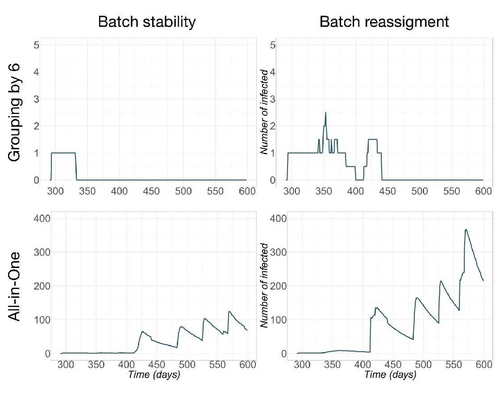
Pig herd management and infection transmission dynamics: a challenge for modellers.Vianney Sicard, Sébastien Picault, Mathieu Andraud https://doi.org/10.1101/2023.05.17.541128Towards models of infection transmission dynamicsRecommended by Marie-Pierre Letourneau Montminy based on reviews by Gustavo Machado and 1 anonymous reviewerEpidemics such as PRRSv-like virus in pig farms has tremendous impact on the competitiveness of swine production. However, its control requires an understanding of the complex interaction between pathogen transmission, disease impact, population dynamics and management. By using mechanistic epidemiological modelling, Sicard et al. (2023) open up a very interesting field of possibilities. This article describes work aimed at assessing the consequences of infections, taking into account the interaction between clinical outcomes and population dynamics. This study shows how this interaction can influence transmission dynamics at the herd level. It highlights the need to further explore this direction, integrating both disease impacts in breeding practices and structural changes in population dynamics, such as pig crossbreeding and grouping methodologies. Reference Sicard V, Picault S, Andraud M (2023) Pig herd management and infection transmission dynamics: a challenge for modellers. bioRxiv, 2023.05.17.541128. ver. 2 peer-reviewed and recommended by Peer Community in Animal Science. https://doi.org/10.1101/2023.05.17.541128
| Pig herd management and infection transmission dynamics: a challenge for modellers. | Vianney Sicard, Sébastien Picault, Mathieu Andraud | <p>The control of epidemics requires a thorough understanding of the complex interactions between pathogen transmission, disease impact, and population dynamics and management. Mechanistic epidemiological modelling is an effective way to address t... |  | Animal epidemiology modelling, Animal health, Bioinformatics, Farming systems, Infectious diseases, Mathematical modelling, Open science, Population dynamics, Veterinary epidemiology | Marie-Pierre Letourneau Montminy | 2023-05-22 15:07:37 | View | |
27 Jul 2023
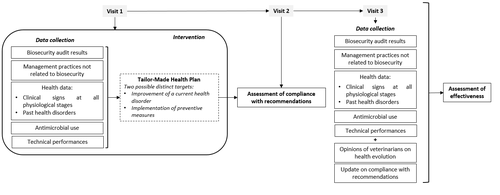
Combining several indicators to assess the effectiveness of tailor-made health plans in pig farmsLevallois Pierre, Leblanc-Maridor Mily, Scollo Annalisa, Ferrari Paolo, Belloc Catherine, Fourichon Christine https://doi.org/10.5281/zenodo.7789634Evaluating tailor-made health plans in pig farms: a multiple complementary indicators approachRecommended by Matteo Chincarini based on reviews by Carla Gomes and 1 anonymous reviewer based on reviews by Carla Gomes and 1 anonymous reviewer
Tailor-made health plans for farming animals, including pigs, are highly beneficial due to their customized nature, addressing the unique needs of each farm and promoting efficient husbandry practices. However, assessing the effectiveness of individualized approaches can be challenging. Levallois et al. (1) tackled this challenge by evaluating the effectiveness of tailor-made health plans of pig farms based on a systematic biosecurity and herd health audit. The study involved twenty farrow-to-finish pig farms, each receiving specific plans tailored to their specific needs. Compliance with the recommendations was monitored over an eight-month period. In the literature, various studies have delved into specific issues in detail, such as disease incidence (e.g., (2)). However, the authors of this research applied a comprehensive approach through an integrative analysis of multiple complementary indicators to provide an effective evaluation of the changes and health disorders. The authors' holistic approach to measuring the effectiveness of tailor-made health plans is noteworthy. They employed up to seven methods to identify advantages and limitations, providing valuable insights for applied research and practitioners in the field of farm animals. Additionally, the study's inclusion of diverse farms, ranging from conventional to antibiotic-free and varying in sow breeding numbers (from 70 to 800), demonstrates the flexibility of the proposed approach, accommodating different farming systems. The study revealed three crucial considerations for future evaluations of tailor-made health plans. Firstly, placing compliance as the primary assessment indicator is a priority. Secondly, it is essential to tailor outcome indicators and monitoring periods according to each farm's specific health disorder. Lastly, a comprehensive understanding of the health disorder's evolution can be achieved through the amalgamation of multiple indicators. While the study does have limitations, such as the relatively short time window for assessment, the methodological framework and results are promising. Further, the discussion of the results raises several areas worthy of future investigation to improve compliance and address farmers' hesitations towards action (i.e., lack of willingness). More research in this context will be beneficial for veterinarians and practitioners, enhancing their understanding and positively impacting both farmers and animals. In conclusion, the study underscores the significant impact of tailor-made health plans on promoting positive changes in farm management. Assessing the effectiveness of these plans enables the refinement of new strategies and enhances the overall quality of work in animal production. The study by Levallois et al (1) sheds valuable light on the challenges and potentials of such plans, providing essential insights for pig farming practices. While further research and improvements are necessary, the study strongly emphasizes the pivotal role of individualized approaches in attaining improved farm management and enhancing animal welfare. 1. Levallois P, Leblanc-Maridor M, Scollo A, Ferrari P, Belloc C, Fourichon C. (2023). Combining several indicators to assess the effectiveness of tailor-made health plans in pig farms. Zenodo, 7789634. ver. 3 peer-reviewed and recommended by Peer Community in Animal Science. https://doi.org/10.5281/zenodo.7789634 2. Collineau L, Rojo-Gimeno C, Léger A, Backhans A, Loesken S, Nielsen EO, Postma M, Emanuelson U, grosse Beilage E, Sjölund M, Wauters E, Stärk KDC, Dewulf J, Belloc C, Krebs S. (2017). Herd-specific interventions to reduce antimicrobial usage in pig production without jeopardising technical and economic performance. Preventive veterinary medicine, 144:167-78. https://doi.org/10.1016/j.prevetmed.2017.05.023 | Combining several indicators to assess the effectiveness of tailor-made health plans in pig farms | Levallois Pierre, Leblanc-Maridor Mily, Scollo Annalisa, Ferrari Paolo, Belloc Catherine, Fourichon Christine | <p style="text-align: justify;">A tailor-made health plan is a set of recommendations for a farmer to achieve and maintain a high health and welfare status. Tailored to each farm, it is intended to be an effective way of triggering change. This st... |  | Animal health, Veterinary science | Matteo Chincarini | 2023-03-31 19:02:35 | View |
MANAGING BOARD
Karol B Barragán-Fonseca
Mohammed Gagaoua
Rachel Gervais
Florence Gondret
Francois Meurens
Rafael Muñoz-Tamayo
Anna Olsson
Seyed Abbas Rafat
Yuliaxis Ramayo-Caldas









